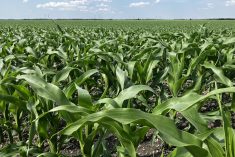Chicago | Reuters –– Cash market sales of corn and soybeans will probably be slow around the U.S. this fall as weakness in the futures market and crumbling basis levels have left prices well below growers’ targets and threatened profitability.
But the downturn has not killed farmers’ hopes for a fall rally, even with expectations of robust production building as harvest nears.
“They got bulled up in June and early July when they saw everything that was underwater,” and Indiana grain dealer said. “They will gamble.”
Read Also

India slaps 30 per cent import duty on yellow peas
India has imposed a 30 per cent duty on yellow pea imports with a bill of lading date on or after Nov. 1, 2025.
As heavy rains gave way to favorable growing weather, Chicago Board of Trade (CBOT) November soybean futures, which track the crop that will be harvested in the coming weeks, have fallen 17 per cent from their summer peak. Prices bottomed out at the lowest September price for the new-crop soybean futures contract since 2006.
December corn futures were down 19 per cent from their summer peak.
At current prices, most farmers are likely to take a loss on any corn or soybeans they sell as production costs outstrip what is being offered on the cash market.
That reckoning has made storage an attractive option, even as most analysts see a bleak outlook for prices due to the abundant supplies and weakening export demand.
“I think most guys are probably looking to store on farm,” said Ryan Wagner, a farmer at Roslyn, S.D., about 200 km south of Fargo.
“If they cannot find the room on farm, they will probably let the elevator store it and then pay the storage fee, thinking that a rally might outpace… what they have got to pay in storage.”
Both corn and soybean futures have rallied in October and November in six of the last 10 years, giving farmers hope for a similar move this fall. Corn has gained an average 14.9 per cent during harvest rallies, while the average soybean gain has been 12.7 per cent.
Also, many farmers locked in prices for some of their fall crops during a rally from mid-June to mid-July that pushed new-crop corn futures up 25 per cent to a one-year high. New-crop soybean futures gained nearly 17 per cent in that time, peaking at an eight-month high on concerns about excessive rains limiting production.
Those summer sales will provide many farmers with enough cash flow during the fall to delay booking new sales unless they have to cover a big expense.
“If they can afford to store it,” Wagner said, “I think they will.”
— Mark Weinraub is a Reuters correspondent covering grain markets from Chicago.











